Today we took a trip out to Malmesbury to visit the Abbey and Abbey House Gardens and discovered a lovely little market town that is well worth a visit.
Malmesbury
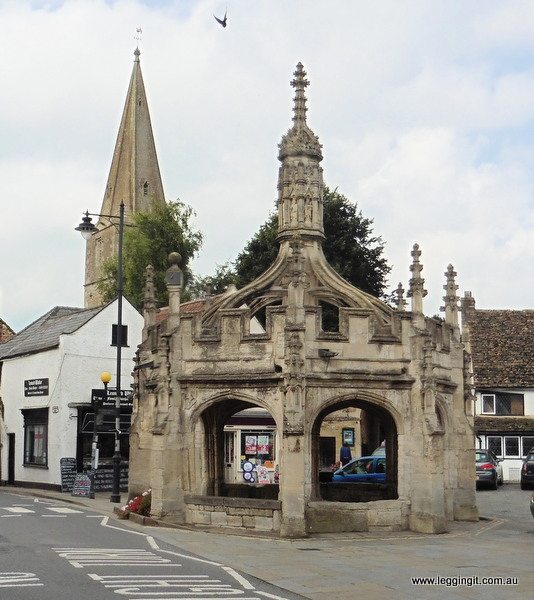
Malmesbury is Englands oldest town and was of the most important West Saxon strongholds. After the Battle of Brunanburh the citizens of Malmesbury were granted land for their part in defeating the invaders. The Battle of Brunanburh, described as the most important Anglo-Saxon battle prior to Hastings saw King Athelstan and his brother Edmund I defeat the combined force of the Viking King of Dublin, and the Kings of Scotland and Strathclyde. It was in Malmesbury that King Athelstan felt safest from the machinations happening behind scenes for his crown by the West Saxons.
Malmesbury Abbey
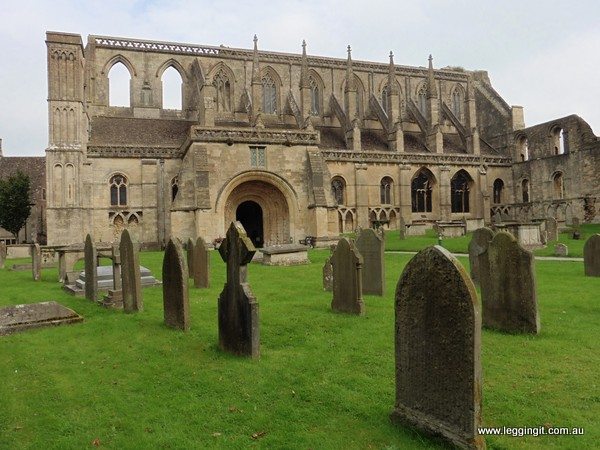
The Malmesbury Abbey dates from the seventh century when a hermitage was built by Maildubh, an Irish monk to teach local children. Late in the seventh century, the area was conquered by the Saxons who founded a Benedictine monastery on the site. After the death of Maildubh, the nephew of King Ine of Wessex, Aldhelm was appointed the first Abbott.
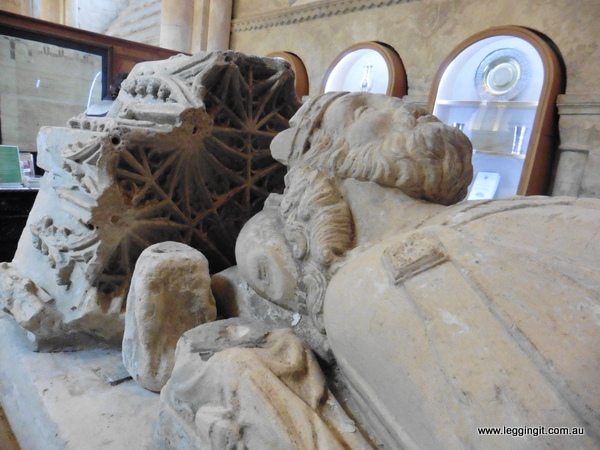
The Abbey was important to the Saxon kings and after King Athelstan died in Gloucester, his body was transported back to be buried in the abbey in 941. There is also a memorial tomb in the Abbey for him.
It was home to a mint, had the second largest library in Europe and was once one of the leading European centres of learning.
The most incredible fact about the Abbey was it was the site of an early attempt at human flight. Back in the early 11th century, Eilmer one of the monks attached wings to his body and jumped from the church tower. He supposedly flew over 200 metres before breaking both his legs trying to land. He supposedly said he would’ve flown further if he had attached a tail.
The Dissolution of Monasteries throughout England by Henry VIII saw the abbey and lands sold in 1539 to William Stumpe who used the abbeys buldimgs as a wool store.
In 1541 the local parish church of St Paul’s was in such a bad state of repair that it was in danger of falling down. William Stumpe donated the abbey to replace it and it became the parish church of St Peter and St Paul.
In 1550 the bell tower was struck by lightning and collapsed destroying most of the nave and transept of the church. A wall was built to block the gaping hole and what is left is only about one third of the original church. At the rear the ruins of the transept is still visible.
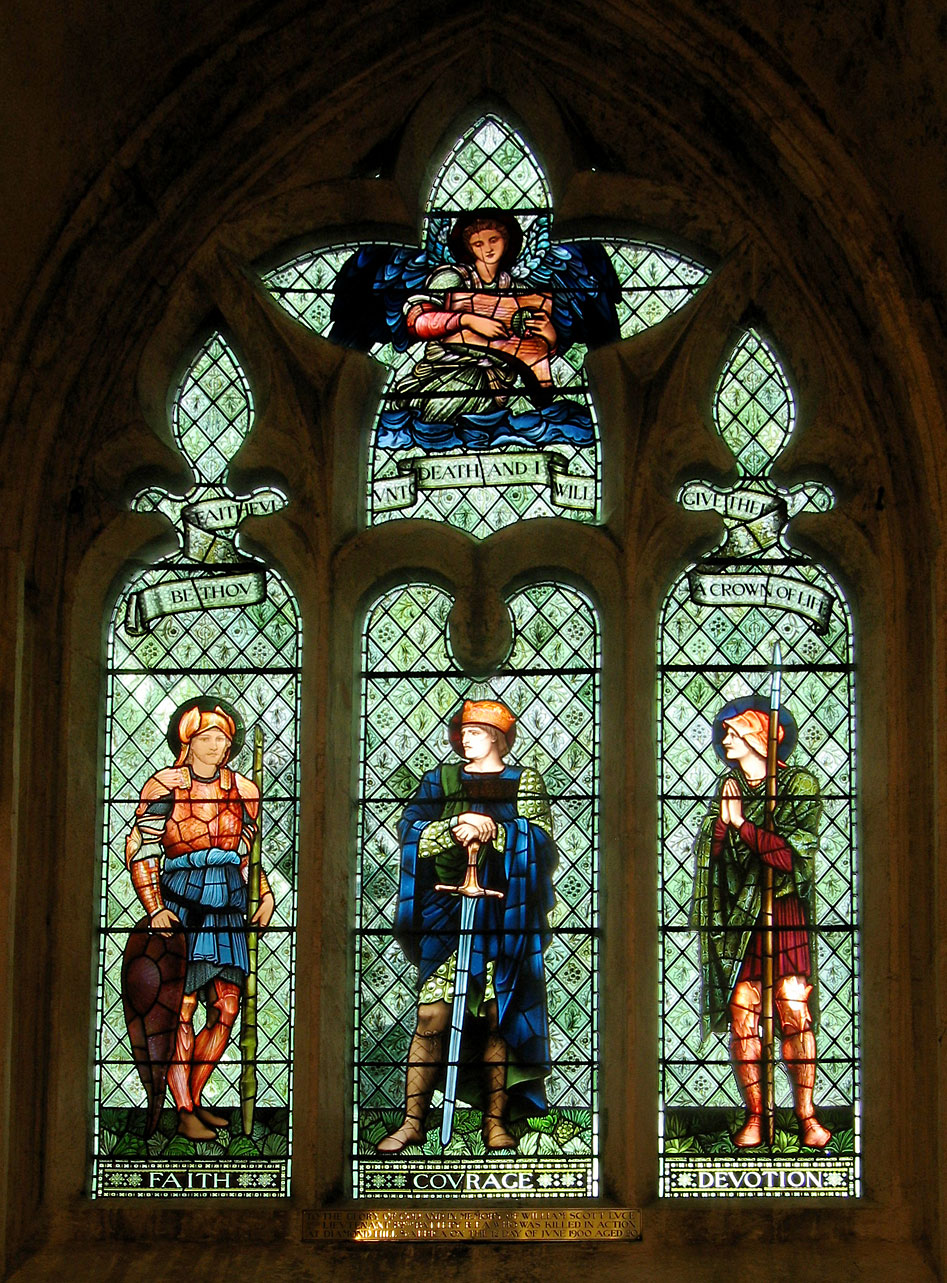
Also commemorated in the abbey with a window and various plaques is the Luce family. The Luce family are a famous Naval family with Rear Admiral Luce the former first sea lord. Various members of the family have taken part in some of the major naval battles of the 20th century including the sinking of the Bismarck. The family were soldiers, pilots, parliamentarians and diplomats. If you’re a Miranda fan you’d be surprised to know she’s the rear admirals great grand daughter.

Entering the abbey church we were quite amazed how friendly and inviting the people were. Like some churches throughout Europe the abbey has a cafe which really adds to the welcome atmosphere. Also a large sign spells out that kids are welcome in the church and goes as far as listing some good reasons why. They even open up for Skateboarding competitions keeping it alive.

The abbey also has a 600 year old bible on display. The bible consists of four parts written on vellum. The display explains the process that the monks undertook to produce the bible. The pages of the bible are decorated with colour and are just a beautiful piece of craftsmanship. Also on display in the church are books dating back to the 1500’s.
One of those was Martin Luthers commentary upon the Epistle to the Galatians published in 1573. It’s one of the more important historical books associated with Protestantism.
The interior of the abbey has some nice architectural touches. Solid round pillars support Romanesque arches decorated with pillars which in turn support the third level of clear glass windows. Above the nave is a royal box and the nave features a vaulted ceiling. Around the walls of the abbey bullet holes are still visible from the English civil war. Malmesbury changed hands about seven times and the Abbey didn’t escape damage.
Malmesbury Abbey really has some fascinating history attached to it.
Malmesbury Abbey is free to visit, opening hours are available here
Hannah Twynnoy
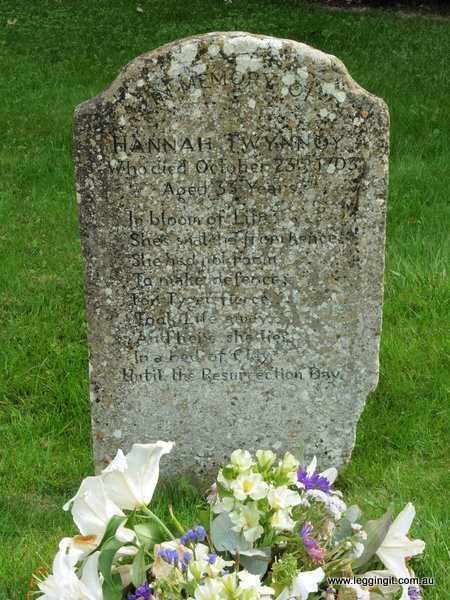
In the cemetery is the interesting grave of Hannah Twynnoy. In 1701 she was the first person in England to be killed by a tiger. She was a barmaid working in a local tavern when a tiger in a menagerie killed her. Her gravestone has a flowery poem about her death and interestingly was adorned with fresh flowers.
Athelstan Museum
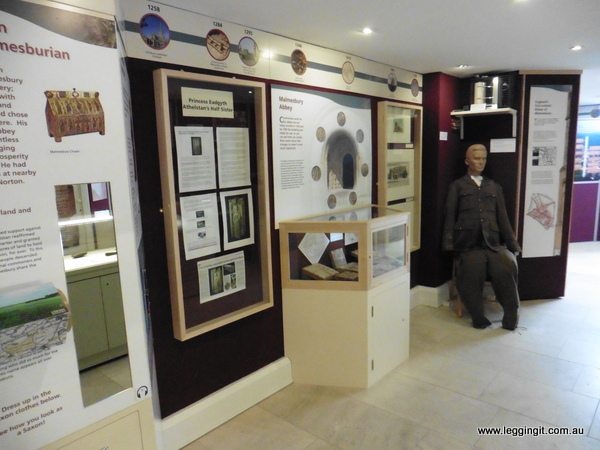
After visiting the Abbey we decided to have a look around the town. Near the Abbey is the Market Cross, an interesting circular stone structure from the 1500’s.
In the centre of Malmesbury we discovered Athelstan Museum so we decided to take a look inside.
Athelstan Museum is a one room museum in the heart of Malmesbury. Although named Athelstan Museum it traces the history of Malmesbury with all sorts of interesting exhibits. The museum is free to enter and includes the use of an audio guide. For a small museum we were quite impressed with it’s design as they want kids to learn and explore with the clever use of multiple forms of media. There’s dress up clothes, drawers to open, things to twist, buttons to push and things to touch. The displays tell the history of Malmesbury from Neolithic times, through Roman occupation and Saxon invasion.
It tells the story of some of the famous people like Saxon King Atholstan and the ‘Flying Monk’ Eilmer with his famous flight. They tell the story of the lightning bolt which blew the gold ball off the Abbeys bell tower to land in the main street and the subsequent collapse of the abbey. They also tell the story of the boom in the local wool trade and the Malmesbury lace industry. One fascinating question posed was which was worth more a gold bracelet or a lace cuff. Surprisingly for me (not for Michele) the lace was more expensive. The museum conducts lace making classes occasionally as part of getting the community in touch with its history.
In the upper landing of the museum is the World War commemoration. Names and biographies of some of the local people who died during the wars are on display with plenty to read.

Another fascinating display was the Tiger display. It tells the tale of Hannah Twynnoy, the first person to be killed by a tiger in England. We visited her flower draped grave at Malmesbury Abbey graveyard. It tells the story of how she was working in a local tavern, supposedly teased the tiger from a menagerie and it killed her. The menagerie owner must’ve felt some guilt for her death as her gravestone was pretty grand and contained a poem about her death.
Also in the museum is the Malmesbury coin hoard. It was discovered in a field at nearby Millbourne in 2012. The hoard consisted of 1266 roman coins from different Roman emperors Constantine, Licinius, Maximianus, Allectus dating from around the late 3rd to early 4th century. The surprising thing about the coins is they were minted in different parts of the Roman Empire; London, Trier, Lyon, Arles, Siscia, Ticinum,Ostia, Rome. It’s quite fascinating looking at a hoard of this size to consider a few different questions. Who buried them? When were they buried? Why were they buried? Where they a bank? Why weren’t they dug back up?
The Athelstan museum was fascinating to visit and the volunteer staff were so friendly. It gave us a great insight into the towns history.
Entry to the Athelstan Museum is free and opening hours can be found here
Abbey House Gardens
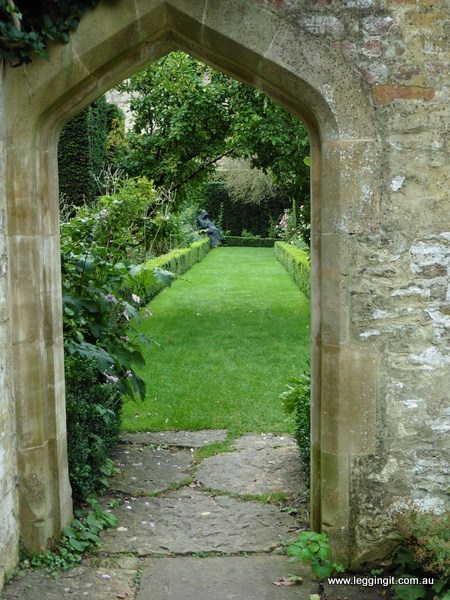
Our last place to visit was the actual reason we came to Malmesbury, to explore the Abbey House Gardens. Situated behind the Abbey in the former Abbey buildings the Abbey House Gardens are one of the more interesting gardens we’ve visited. The gardens are set over five acres of land running from the hill behind the abbey down to the river. The garden gained a lot of attention from its owners Ian and Barbara Pollard, who created their garden of Eden.
Known as the ‘naked gardeners’ they piqued the general publics curiosity by admitting they enjoyed being in the buff. They set up photo shoots of them gardening without a stitch on which drew huge interest. They even opened the gardens up for clothing free days a few time.
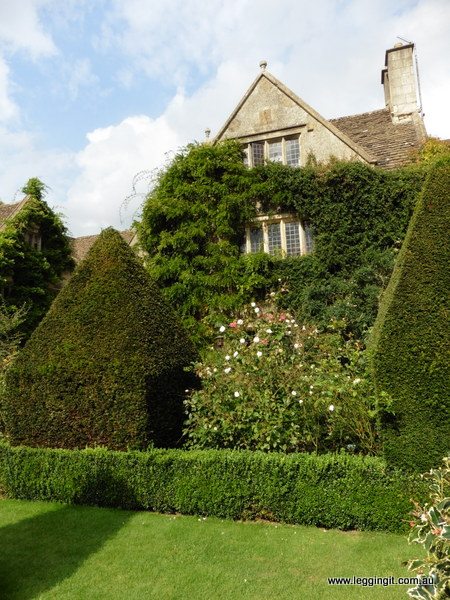
The gardens feature a Tudor house covered in climbers which provide a great backdrop to the property. In the upper gardens are elements of formality with hedges and flower beds. Water features filled with massive carp and hedges which lead to a focus point.
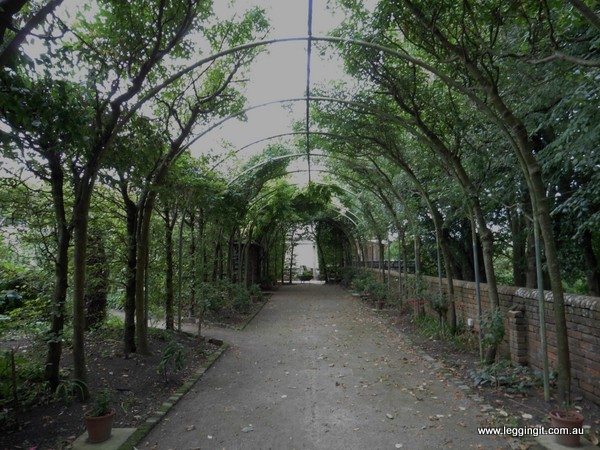
They lead into a less formal area of arched pergolas covered in fruit trees and grapes. In the centre wooden boxed plant beds are a real feature. In the garden are around 10,000 plants with a large variety of roses throughout. The feature of the gardens is little nooks where we were able to feel alone to enjoy the gardens.

A path leads down from the cafe towards the river through woodland gardens. From the path there’s great views across the river to a hut built on a small knoll. Built from a cask it has the most fascinating roof line. There’s also some lovely touches such as weeping trees surrounding stepping stones across the river and a wooden drawbridge. Throughout the gardens, various statues and sculptures are placed to catch the eye and make you think. Some are a little risqué, but in good taste.
It really was a fascinating and beautiful garden and well worth the visit. If you can get there in Spring you will find it covered in spring flowers so it would be quite stunning.
Entry to Abbey House Gardens is £7.50 and opening hours are available here
As the weather had turned overcast we decided to call it quits and head back to Warleigh.



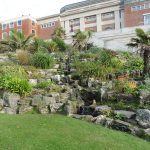
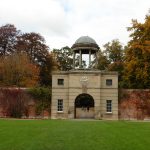


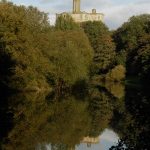
Would love to walk those halls and gardens. Love the greens and the fact there’s a skateboarding competition!
It is always nice to visit somewhere there is lots of life and involves the community and the skateboarding competition just added to it
Malmesbury Abbey must have been grandiose in its days of glory.
I am sure it was so imposing sitting on the hill overlooking the countryside…
Ron, you and Michele always capture perfectly the areas you and the princess travel to. I have never heard of Malmesbury but it looks like a beautiful little town with some interesting history.
It was Lyn being so small we only expected a half day visit.
What a lovely town and so much history! I have been really surprised how much some of the small towns in England have to offer. That abbey is impressive. Thanks for sharing on #TheWeeklyPostcard
We are surprised too, we expected to spend a few hours and spent nearly the full day wandering around.
I grew up in Malmesbury, and still go back when I can – it’s lovely to hear that people still enjoy visiting. It really is a beautiful little town, though it has grown a lot in recent years as Dyson have a large facility on the edge of town.
The Abbey is very impressive, and really is the centre of the community in many ways. I sang in the choir there for many years, but even now it takes my breath away slightly when I go in.
I’m not sure if you picked this up on your visit to the museum, but in gifting land to the residents, King Athelstan created the Commoners, who still exist as a group. They generally claim direct descendance from the original Commoners (though it’s likely that the title was awarded to others over the years who were not descendants). They still own land and property in the town and pass the title down from father to son and, happily, now to daughters as well.
Ron apparently did pick that up but I didn’t how interesting (glad the daughters now get a part of it too) It is a lovely little town and we really enjoyed our visit, it really proved out point that every little place has a story and is worth a visit.